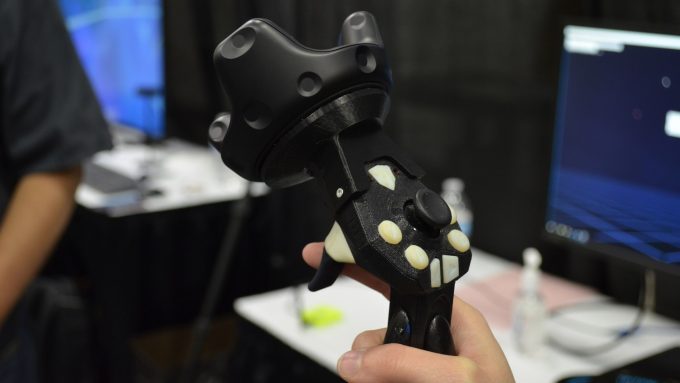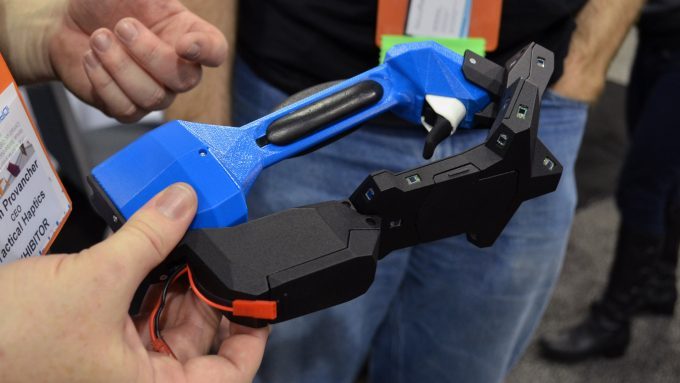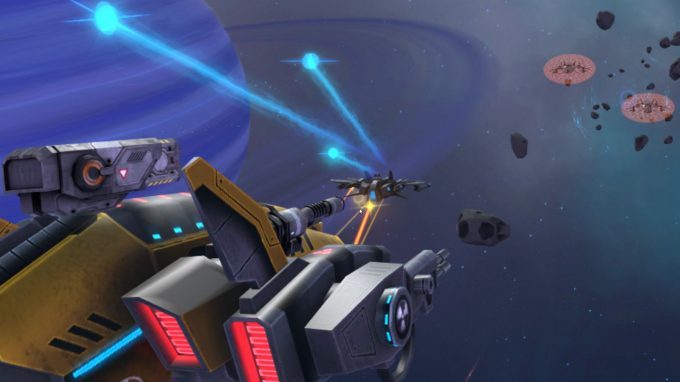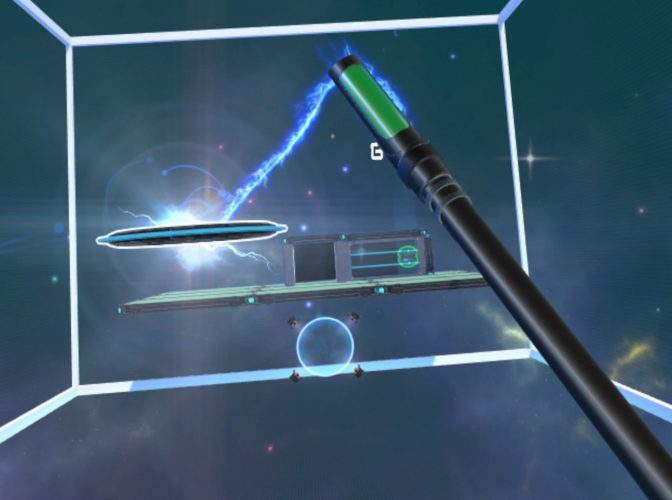Tactical Haptics, developers of the Reactive Grip controller, are showing their latest prototypes now with attachments for the Vive Tracker, Oculus Touch, and a custom-built SteamVR Tracking solution. The controller employs a unique solution to haptic feedback which aims to recreate the feeling of friction against objects in your hands rather than just rumble. The company is moving toward bringing a development kit of the device to developers.
Tactical Haptics has been in development of their Reactive Grip haptic technology for several years now. Having shown off some of their earliest prototypes at GDC 2013—years before HTC and Oculus even began talking about VR motion controllers—tracking has remained a hurdle in getting the product ready for consumers. This (old) video shows the foundation of the haptic technology which we’ve said ‘proves VR needs more than rumble‘.
Vive Tracker and Oculus Touch Tracking
Now that both Oculus’ Constellation and Valve’s SteamVR Tracking systems are deployed in users’ homes, the door is open to using those systems as add-ons to track the Reactive Grip controller for use in VR. That means users who already own Touch or a Vive Tracker can attach those peripherals without the need to bear the cost of additional tracking hardware built into the controller.
 While the company had shown off a similar approach previously by attaching the Vive controllers to their haptic controller, Tactical Haptics founder William Provancher says that between the Vive Tracker and Touch controllers, the lighter weight and more compact profiles make the overall device lighter, more balanced, and more comfortable to use. Though that’s not to say that Vive controller adapter might not be offered when the Reactive Grip controller becomes available.
While the company had shown off a similar approach previously by attaching the Vive controllers to their haptic controller, Tactical Haptics founder William Provancher says that between the Vive Tracker and Touch controllers, the lighter weight and more compact profiles make the overall device lighter, more balanced, and more comfortable to use. Though that’s not to say that Vive controller adapter might not be offered when the Reactive Grip controller becomes available.
Custom SteamVR Tracking
 Thanks to Valve opening up their tracking solution to third-parties over the seven months, Tactical Haptics is also experimenting with a custom SteamVR Tracking solution which could be offered for those who want to buy an all-in-one controller. Provancher says the company attended the SteamVR Tracking development course and had created a working SteamVR Tracking integration for the controller in just a few weeks. Though the company is still refining the integration, Provancher says early tests reveal that it tracks just as well as the Vive Tracker.
Thanks to Valve opening up their tracking solution to third-parties over the seven months, Tactical Haptics is also experimenting with a custom SteamVR Tracking solution which could be offered for those who want to buy an all-in-one controller. Provancher says the company attended the SteamVR Tracking development course and had created a working SteamVR Tracking integration for the controller in just a few weeks. Though the company is still refining the integration, Provancher says early tests reveal that it tracks just as well as the Vive Tracker.
– – — – –
At GDC 2017 this week, the company was showing off the new controller prototypes with new mini-games made to show what its like to develop for the controller and what sorts of applications the unique haptic feedback can be applied to.
 Using the Reactive Grip controller, I played a game that was something like ‘VR Asteroids’ where I used my hand to fly a little ship around to avoid asteroids and incoming fire from enemy ships. Using the orientation of the controller and the trigger, I could fire the ship’s weapons to destroy asteroids and enemy ships. The controller’s haptics gave me a sense of the ships momentum in my hand and feedback as my ship took damage and fired its weapons.
Using the Reactive Grip controller, I played a game that was something like ‘VR Asteroids’ where I used my hand to fly a little ship around to avoid asteroids and incoming fire from enemy ships. Using the orientation of the controller and the trigger, I could fire the ship’s weapons to destroy asteroids and enemy ships. The controller’s haptics gave me a sense of the ships momentum in my hand and feedback as my ship took damage and fired its weapons.
 The other game, Cyber Golf, was like a futuristic version of disc golf where the goal was to throw the disk into a goal which was blocked by obstacles. In the game I held a wand-like tool which could be used to grab the disk. Grabbing on the disc’s edge let me throw it like a frisbee, while grabbing the core extended a laser-rope from the wand-tool that let me whirl the disc over my head like a lasso and then throw it for extra distance. While spinning the disk over my head, the controller gave me a sense of the disc’s weight as its momentum pulled the tool in a circular motion in my hand.
The other game, Cyber Golf, was like a futuristic version of disc golf where the goal was to throw the disk into a goal which was blocked by obstacles. In the game I held a wand-like tool which could be used to grab the disk. Grabbing on the disc’s edge let me throw it like a frisbee, while grabbing the core extended a laser-rope from the wand-tool that let me whirl the disc over my head like a lasso and then throw it for extra distance. While spinning the disk over my head, the controller gave me a sense of the disc’s weight as its momentum pulled the tool in a circular motion in my hand.
Both mini-games were fun and functional, but not the most compelling demos I’ve seen (and felt) from these controllers. Prior demos that I’ve tried using the controller—like gun shooting, sword wielding, and using a ‘Gravity Gun’-like tool to swing boxes around—gave me a more immersive sense of connection between what I was doing and how the haptics felt on my hand. But, importantly, the new mini-games on display at GDC show how the tech can be applied in a more abstract way, which opens the doors to more gameplay possibilities that would make use of the controller’s unique haptics.
In November, Tactical Haptics announced that they’d raised $2.2 million to finalize a development kit of the Reactive Grip controller, and now the company has begun soliciting developer interest for dev kits. The company suggests reaching out by email to info@tacticalhaptics.com for more details about development kits.






